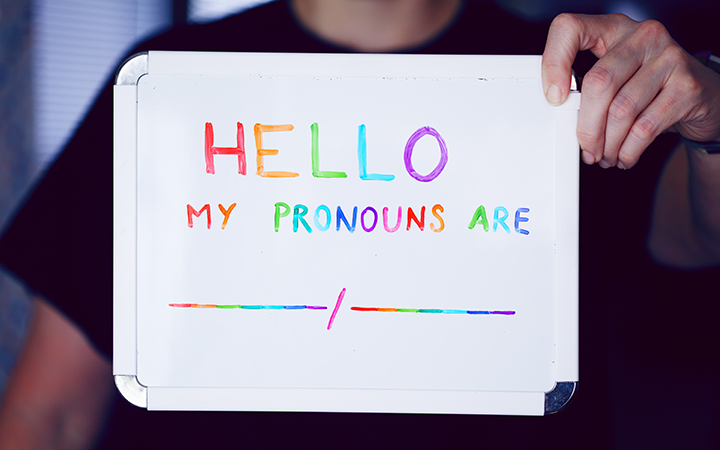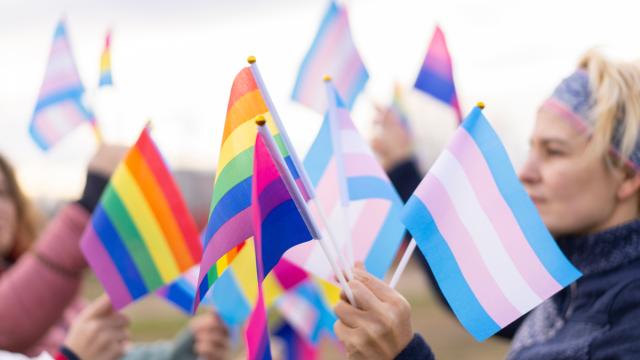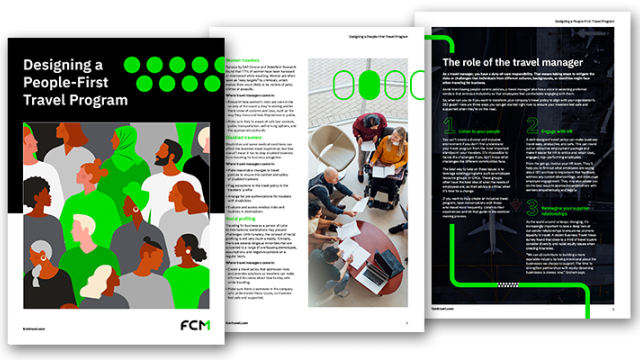Insight
He/She/They: Prioritizing Personal Pronouns

You’ve probably seen the following popping up on social media profiles or email signatures after people’s names: she/her, he/him, they/them, or even they/he or she/they. But what does it mean?
It’s actually not that complicated! Pronouns simply replace a proper noun, or name, in conversation. Instead of saying “That’s Trevor’s coat” you could say “That’s his/her/their coat.”
Pronouns have been deep within the ongoing conversation of gender and gender identity. Before we dive into how to correctly use personal pronouns, let’s define the differences between sex, sexual orientation, and gender.
Sex refers to a person’s biological status and is typically assigned at birth (male, female, intersex).
Gender is often defined as a social construct of norms, behaviors, and roles that varies between societies and over time (man, woman, nonbinary).
Sexual orientation refers to physical, romantic and/or emotional attraction to members of the same and/or other genders (straight, gay, bisexual, lesbian, etc.)
See how they’re all different? It’s important to note that no matter what someone was assigned at birth (male/female/intersex), their gender identity exists separately. It’s gender identity that tends to influence pronouns.
Pronouns & Business Travel
Using a person’s correct pronouns is a matter of respect, and organizations around the world are listening. Some government authorities allow passport holders to use non-binary identifiers, while others have said no to the move. However, even where passports are issued with a non-binary gender marker such as U or X, it cannot guarantee entry or transit through other countries, or travellers may face restrictions in countries that don't recognize those markers.
If you know your traveller has an X on their passport, you’ll want to ensure you’re sending them to locations that will honor and affirm their gender identity and not put them at an increased risk. As of 2024, 62 UN member states still criminalize LGBTQ+ people with death penalty being legally prescribed punishment for LGBTQ+ people in 7 UN member states. If you need more information on the 2SLGBTQIA+ environment in a particular country, you can check out resources such as the Country Information page on the U.S. State Department’s website, for example.

Gender Identity and Travel Technology
Once you know a traveller’s personal pronouns, it’s important you make sure their gender identity is affirmed throughout the travel process. While many HRIT systems have started to include pronoun selections in their employee profiles, it’s a bit more complicated for travel tech.
There has been a positive movement toward making travel tech more gender-affirming. Many airlines let travellers choose a non-binary gender identifier when booking trips, and as of February 2023, the FCM Platform also lets travellers choose pronouns that reflect their gender identity on their travel documents, either F, M, U, or X.
But while many companies in the corporate travel industry are working together to ensure technology supports travellers of all genders, the profile still needs to sync with other systems to really operate seamlessly. Airlines, hotels, TMCs and other travel organisations all need to collaborate to address the barriers to a seamless travel experience for transgender and non-binary travellers.
The journey of affirming gender identity in travel still has a long way to go, but the first place we can start is with our tech and policies. Talk with your Account Managers and let them know your organisation’s desire for more gender inclusivity, especially adding personal pronouns. Now that more and more countries around the world adopt this change, the need to for our tech and procedures to adapt is more important than ever.
Next Steps
There are simple things you can do to start your organisation on the right path to gender equity and inclusion. Encourage employees to include personal pronouns in their email signatures, virtual meeting profiles, and nametags at in-person events. Switch to HRIT systems that support personal pronouns and pass out literature that helps employees and business travellers understand the importance of respecting personal pronouns and gender identity. Together, we’ll make the business travel world an even more inclusive place.


